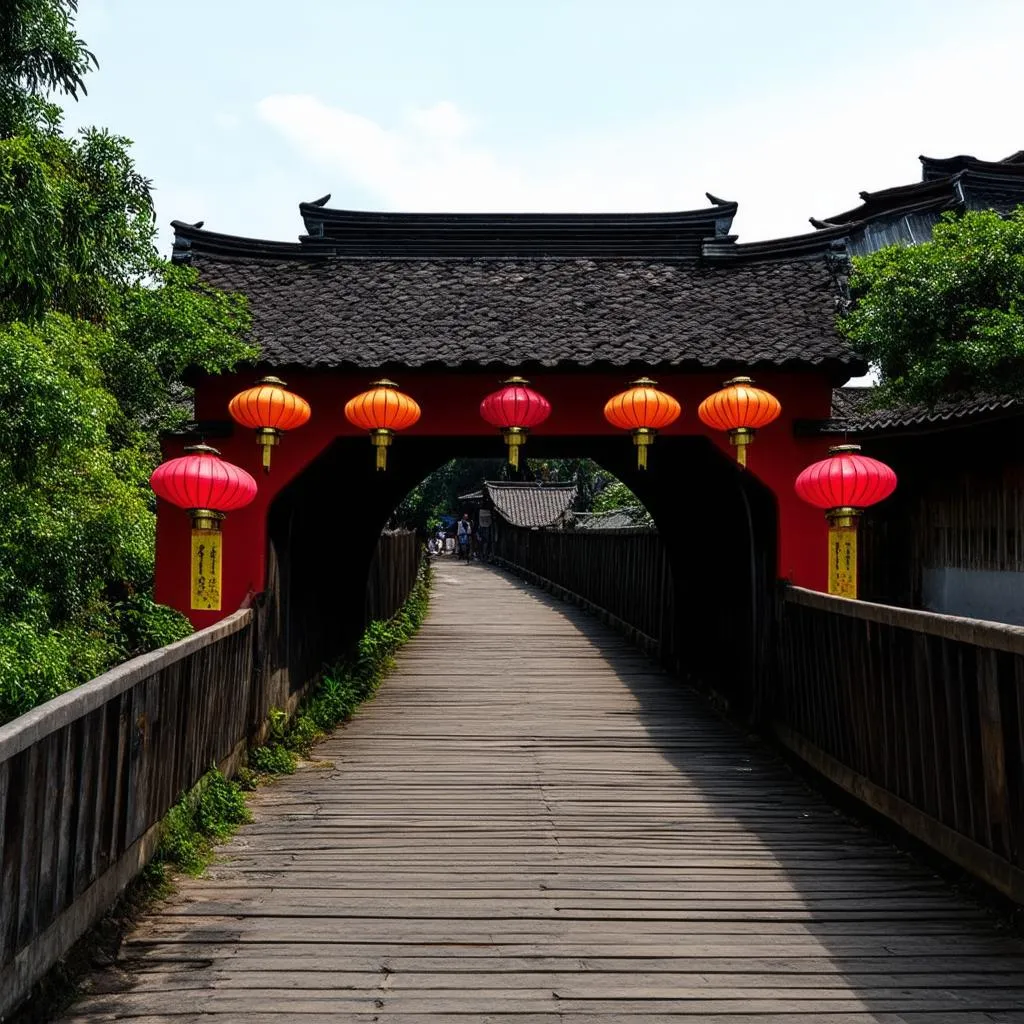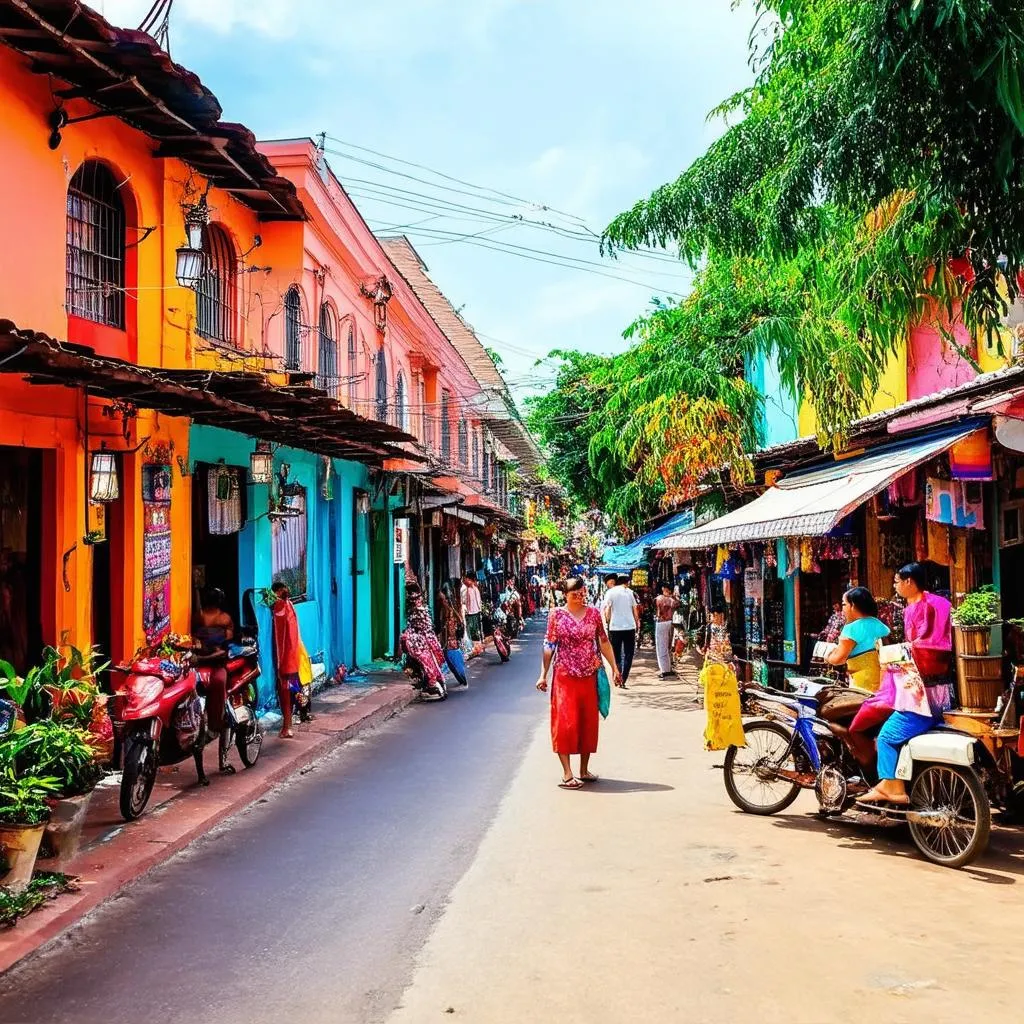Have you ever dreamt of stepping back in time, where lanterns illuminate cobblestone streets and ancient houses whisper tales of centuries past? Hoi An Ancient Town, a UNESCO World Heritage Site, offers exactly that and more. But navigating this enchanting labyrinth can be tricky. Fear not, fellow traveler! This comprehensive guide, complete with a “map of Hoi An Ancient Town,” is your key to unlocking the magic.
Exploring Hoi An with Your Travel Map
A map of Hoi An Ancient Town is your compass and treasure map rolled into one. It reveals the network of charming streets, each with its own character and secrets to uncover.
Navigating the Heart of Hoi An
Imagine yourself strolling down Tran Phu Street, the bustling heart of the old town. This vibrant artery is lined with tailor shops displaying exquisite silks, art galleries showcasing local talent, and charming cafes offering a taste of Vietnamese coffee culture.
 Hoi An's bustling Tran Phu Street
Hoi An's bustling Tran Phu Street
Venture deeper, and you’ll discover hidden gems like Japanese Covered Bridge, an iconic symbol of Hoi An’s rich history. This architectural marvel, dating back to the 16th century, connects the ancient town with the Japanese quarter.
 Iconic Japanese Covered Bridge in Hoi An
Iconic Japanese Covered Bridge in Hoi An
Beyond the Beaten Path
Don’t be afraid to veer off the main streets and explore the quieter alleys. Here you’ll find hidden temples like Phuc Kien Assembly Hall, adorned with intricate carvings and offering a glimpse into the town’s Chinese heritage. Local life unfolds before your eyes as you observe artisans at work and smell the aromas of traditional dishes wafting from family-run restaurants.
Planning Your Hoi An Adventure
Creating Your Itinerary
Day 1: Begin your journey by immersing yourself in the heart of Hoi An Ancient Town. Explore the Japanese Covered Bridge, visit the Fukian Assembly Hall, and wander through the bustling Central Market. In the evening, take a boat ride on the Thu Bon River and marvel at the illuminated town.
Day 2: Delve deeper into the cultural tapestry of Hoi An. Visit the Museum of Trade Ceramics and the Museum of Sa Huynh Culture. In the afternoon, learn the art of lantern making or take a cooking class to master the secrets of Vietnamese cuisine.
Day 3: Escape the town’s bustle and discover the tranquility of nearby attractions. Cycle through the picturesque countryside to Tra Que Vegetable Village or relax on the pristine sands of An Bang Beach.
Essential Tips for Your Trip
- Best Time to Visit: Hoi An enjoys a tropical climate. The dry season, from February to July, offers pleasant weather for exploration.
- Getting Around: The ancient town is best explored on foot. Bicycles and cyclos are readily available for venturing further afield.
- Respectful Attire: When visiting temples and pagodas, dress modestly, covering your shoulders and knees.
Hoi An FAQs
Q: Is there an entrance fee for Hoi An Ancient Town?
A: Yes, a ticket is required to enter the ancient town and visit its attractions. The ticket cost is VND 120,000 (approximately USD 5) and is valid for multiple entries over a specified period.
Q: What are some must-try dishes in Hoi An?
A: Hoi An is a foodie’s paradise! Don’t miss out on Cao Lau (a noodle dish unique to Hoi An), Mi Quang (turmeric noodles with pork and shrimp), and White Rose dumplings.
Embrace the Magic of Hoi An
Hoi An Ancient Town is more than just a destination; it’s an experience. It’s a place where history, culture, and natural beauty intertwine to create an unforgettable journey. Use this guide and your trusty Hoi An Ancient Town map, and let the magic of this enchanting town captivate your senses.
For more travel inspiration and tips, be sure to explore other fascinating destinations on TRAVELCAR.edu.vn, including our articles on Hanoi travel tips and breathtaking images of Vung Tau.

